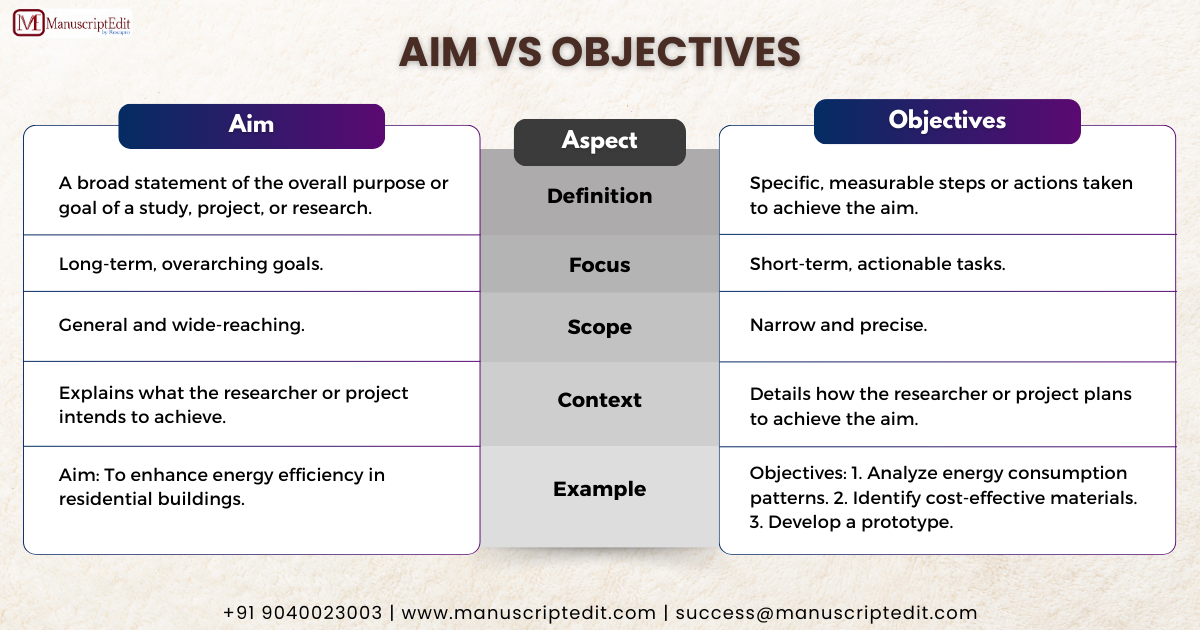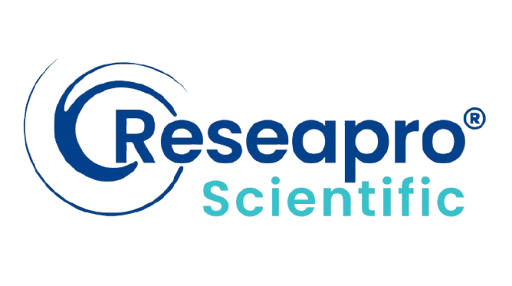Understanding the Difference Between Aims and Objectives in Research
In the field of research, distinguishing between the terms “aim” and “objective” is crucial yet often confusing. Many people use these terms interchangeably, but they represent different aspects of the research process. This comprehensive guide will clarify the difference between aims and objectives, how to use them effectively, and why understanding this distinction is essential for successful research.
What Is the Aim of a Research Study?
The aim of a research study is a broad, overarching statement that defines the general purpose and goal of the research. It addresses the fundamental question of why the study is being conducted and what the researcher hopes to achieve. The aim provides a high-level overview and sets the direction for the entire study. A well-defined aim is crucial as it helps to frame the research questions, guides the research process, and communicates the significance of the study to stakeholders such as funding bodies, academic peers, and the public. It essentially provides the foundation upon which the research is built.
For example, if a researcher is investigating the impact of diet on cardiovascular health, the aim might be: “To explore the effects of dietary habits on the prevalence of cardiovascular diseases in adults.”
What Are the Objectives of a Research Study?

Objectives are specific, detailed statements that outline the steps or actions required to achieve the aim of the study. They break down the broad aim into manageable tasks and provide a clear roadmap for conducting the research. Objectives are more detailed and measurable compared to the aim, and they help operationalize the research process.
The key functions of objectives include:
- Clarifying the Research Question: Objectives refine and specify the research question by detailing the exact aspects of the study to be investigated.
- Identifying Key Variables: They help in pinpointing the key variables and factors that need to be measured or analyzed.
- Outlining the Research Methodology: Objectives provide a structured approach to the research methodology, detailing the methods and procedures that will be employed.
- Ensuring Focus and Direction: By breaking down the aim into smaller tasks, objectives help maintain focus and direction throughout the research process.
Objectives are often framed using the SMART criteria:
– Specific: Clear and unambiguous.
– Measurable: Includes criteria to measure progress and success.
– Achievable: Feasible within the given timeframe and resources.
– Relevant: Directly related to the aim of the study.
– Time-bound: Has a defined deadline for completion.
Examples Illustrating the Difference Between Aims and Objectives
To better understand the difference between aims and objectives, consider the following examples:
Example 1:
– Aim: To investigate the relationship between physical activity and mental health.
Objectives:
– To review existing literature on the relationship between physical activity and mental health.
– To collect data on physical activity levels and mental health indicators in a sample population.
– To analyze the data to determine the influence of physical activity on mental health.
– To draw conclusions based on the findings and make recommendations for future research or interventions.
In this example, the aim is to explore the broader relationship between physical activity and mental health. https://www.manuscriptedit.com/scholar-hangout/explore-the-social-determinants-of-mental-health/The objectives break down this aim into specific tasks, such as reviewing literature, collecting data, analyzing results, and making recommendations.
Example 2:
– Aim: To evaluate the effectiveness of a new teaching method for improving student performance in mathematics.
Objectives:
– To identify the core components and theoretical basis of the new teaching method.
– To implement the teaching method in selected classrooms.
– To collect and analyze data on student performance before and after the implementation.
– To evaluate the effectiveness of the teaching method based on the performance data.
– To provide recommendations for optimizing the teaching method and its implementation.
Here, the aim is to assess the effectiveness of a new teaching method. The objectives detail the steps required to evaluate this effectiveness, including identifying components, implementing the method, collecting data, analyzing results, and making recommendations.
Why Understanding the Difference Matters?
Recognizing the difference between aims and objectives is important for several reasons:
- Clarity: A clear distinction helps in formulating precise research questions and hypotheses, ensuring that the research is well-structured and focused.
- Planning: Well-defined aims and objectives aid in planning the research methodology and resources, allowing for efficient allocation of time and resources.
- Communication: Clearly defined aims and objectives facilitate better communication of the research purpose and scope to stakeholders, including reviewers, funders, and collaborators.
- Evaluation: Objectives provide measurable targets that can be used to assess the progress and success of the research, aiding in evaluating the research process and outcomes.
Conclusion
In summary, while the aim of a research study represents the broad goal or purpose, objectives are specific statements that outline the steps necessary to achieve that aim. Understanding the difference between aims and objectives helps in creating a clear and structured research plan, ensuring that the study remains focused and aligned with its overall purpose. By clearly defining both aims and objectives, researchers can enhance the clarity, effectiveness, and impact of their research.
For more insights and resources on research and academic writing, visit our website [ManuscriptEdit](https://www.manuscriptedit.com). If you have any queries or need assistance, feel free to contact us at support@manuscriptedit.com.
References:
“Thesis Writing.” Google Books, books.google.co.in/books?
Hirsch, E. D. “Objective Interpretation.” PMLA/Publications of the Modern Language Association of America, vol. 75, no. 4-Part1, Sept. 1960, pp. 463–79. https://doi.org/10.2307/460609.
Elevate Your Research to Global Recognition with Manuscriptedit
Are you a dedicated doctor, PhD, or postdoc seeking to showcase your groundbreaking research in prestigious global journals? At Manuscriptedit, we specialize in transforming your research into impactful publications. Our expert services are designed to help you navigate the complexities of academic publishing and achieve recognition in top-tier journals worldwide.
Why Choose Manuscriptedit?
- Expert Guidance: Our team of seasoned professionals understands the intricacies of the publication process. From manuscript preparation to submission, we provide comprehensive support to ensure your research meets the highest standards.
- Global Reach: We have established connections with leading journals across various disciplines. Our expertise ensures your research is presented to the right audience and increases its chances of acceptance in reputed international journals.
- Tailored Services: Whether you need assistance with editing, formatting, or navigating submission guidelines, our services are customized to fit your specific needs. We handle all aspects of the publication process, allowing you to focus on your research.
- Proven Success: Our track record speaks for itself. We have successfully assisted numerous doctors, PhDs, and postdocs in publishing their research in high-impact journals, enhancing their academic and professional standing.
Our Services Include:
- Manuscript Editing: We provide detailed editing services to improve the clarity, structure, and quality of your research paper, ensuring it meets the rigorous standards of top journals.
- Formatting and Compliance: Our team ensures your manuscript adheres to the specific formatting and submission guidelines of your target journals, reducing the risk of rejection due to technical issues.
- Submission Assistance: We guide you through the submission process, including the preparation of cover letters and response to reviewer comments, to enhance your chances of successful publication.
- Personalized Support: Our dedicated consultants offer personalized support throughout the entire publication journey, from initial consultation to post-submission follow-up.
Take the Next Step in Your Academic Career register now For Free Consultation: REGISTER NOW
Publishing in renowned journals can significantly boost your academic profile and open doors to new opportunities. With Manuscriptedit, you gain a trusted partner in achieving your publication goals.






